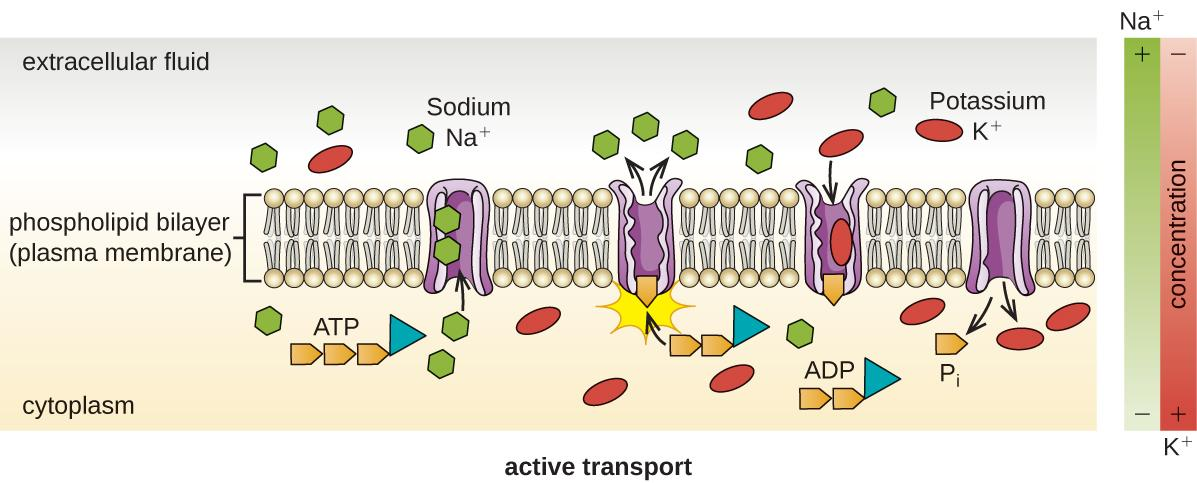
Active transport across cell membrane requires
A. Glucose
B. Steroid
C. Energy in the form ATP
D. Proteins and glucose
Answer
554.7k+ views
Hint: Active transport proteins within the membrane must use energy (ATP) to move substance either to the inside or outside of the membrane. Active transport needs the cell to spend energy, usually in the form of ATP. Active transport contains primary active transport and secondary active transport.
Complete Answer:
Substance passes through the cell membrane by diffusion, osmosis, and active transport. In part of active transport, substance moves against a concentration declension across the cell membrane. So, energy is required. Energy available in the body in the form of ATP is used to move across the cell membrane. Primary active transport uses the energy directly from the hydrolysis of ATP.
- Primary active transport contains pumps:
- Sodium potassium pump
- Calcium pump
- Hydrogen potassium pump
- Proton pump
- Secondary active transport is energy utilized in the transport of one substance helps in the movement of other substances.

Active transport involved in the absorption of dissolved minerals salts by root hairs and glucose and amino acids by cells in the small intestine of humans.
Thus, the option (C) is correct.
Note: Transport mechanism divided into two parts, they are active transport and passive transport process. Passive transport is movement of molecules across a membrane that requires no energy and always occurs down a concentration gradient. Diffusion and osmosis are passive transport. It does not need any other energy. Diffusion is the process of movement of ions. Osmosis is the process of water molecules.
Complete Answer:
Substance passes through the cell membrane by diffusion, osmosis, and active transport. In part of active transport, substance moves against a concentration declension across the cell membrane. So, energy is required. Energy available in the body in the form of ATP is used to move across the cell membrane. Primary active transport uses the energy directly from the hydrolysis of ATP.
- Primary active transport contains pumps:
- Sodium potassium pump
- Calcium pump
- Hydrogen potassium pump
- Proton pump
- Secondary active transport is energy utilized in the transport of one substance helps in the movement of other substances.

Active transport involved in the absorption of dissolved minerals salts by root hairs and glucose and amino acids by cells in the small intestine of humans.
Thus, the option (C) is correct.
Note: Transport mechanism divided into two parts, they are active transport and passive transport process. Passive transport is movement of molecules across a membrane that requires no energy and always occurs down a concentration gradient. Diffusion and osmosis are passive transport. It does not need any other energy. Diffusion is the process of movement of ions. Osmosis is the process of water molecules.
Recently Updated Pages
Master Class 11 Social Science: Engaging Questions & Answers for Success

Master Class 11 Physics: Engaging Questions & Answers for Success

Master Class 11 Maths: Engaging Questions & Answers for Success

Master Class 11 Economics: Engaging Questions & Answers for Success

Master Class 11 Computer Science: Engaging Questions & Answers for Success

Master Class 11 Chemistry: Engaging Questions & Answers for Success

Trending doubts
What is meant by exothermic and endothermic reactions class 11 chemistry CBSE

10 examples of friction in our daily life

Difference Between Prokaryotic Cells and Eukaryotic Cells

1 Quintal is equal to a 110 kg b 10 kg c 100kg d 1000 class 11 physics CBSE

One Metric ton is equal to kg A 10000 B 1000 C 100 class 11 physics CBSE

Draw a diagram of a plant cell and label at least eight class 11 biology CBSE




